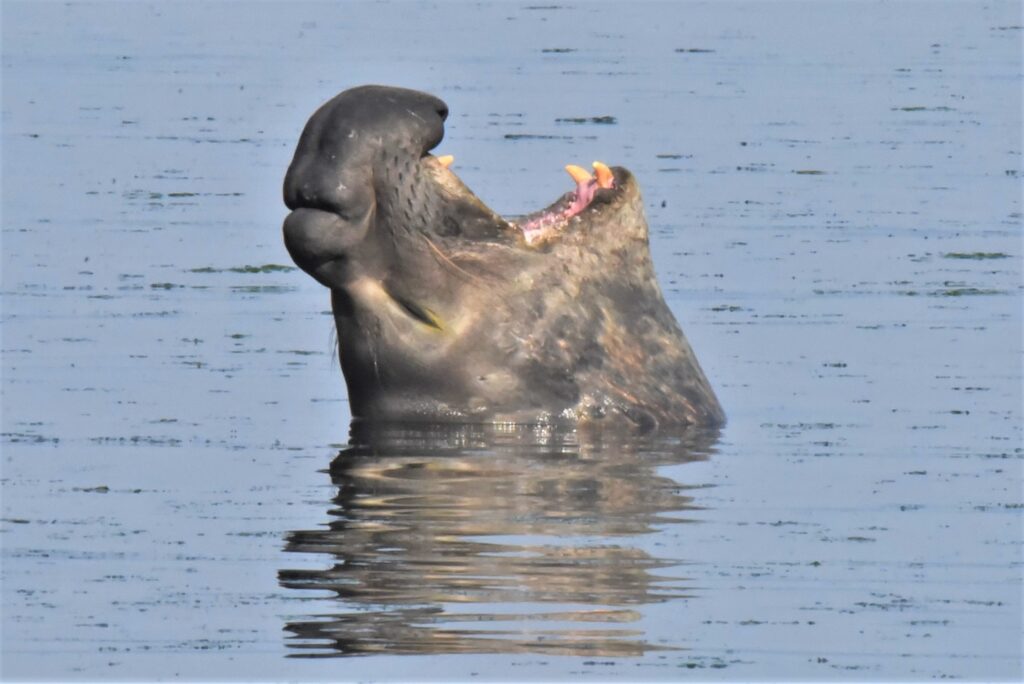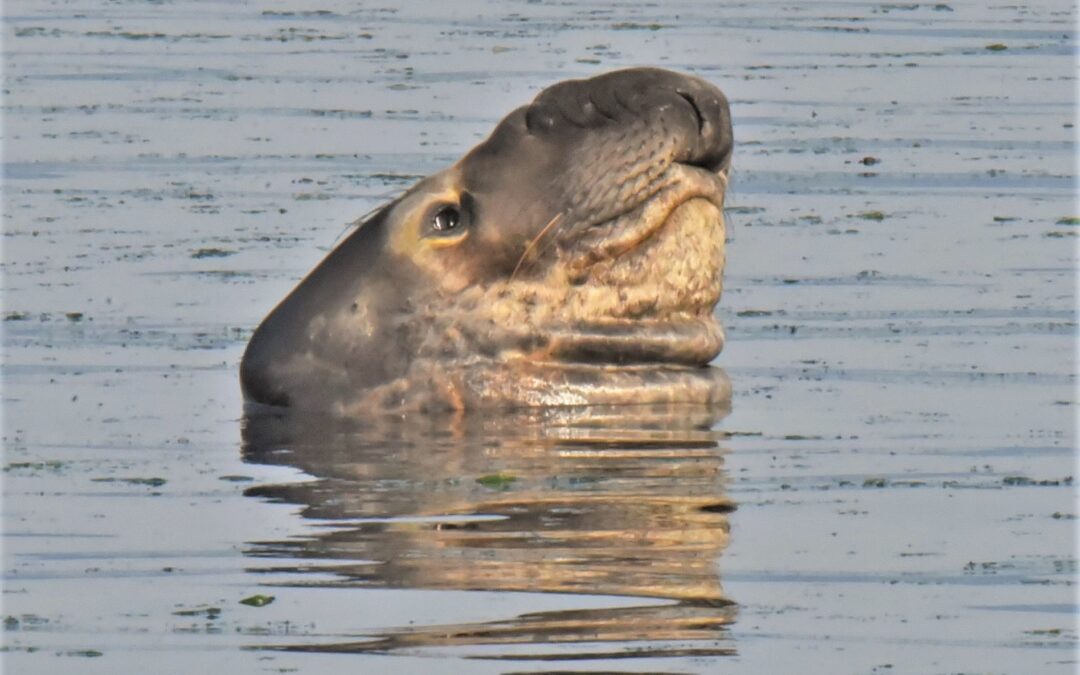Elwood, the young male Northern elephant seal in Tramp Harbor this fall. Credit: Jim Diers
For almost everyone living in the Pacific Northwest over the past century, Northern elephant seals (Mirounga angustirostris) are not considered a common sight. But, over the past few months, Vashon residents have been treated to visits from several elephant seals. A young male dubbed Elwood spent time along Tramp Harbor in October, along with sightings of other individuals earlier in the spring and summer.
Those of us familiar with elephant seals typically associate them with beaches in California, where they come ashore to breed and molt. Northern elephant seals range from the coast of Baja, Mexico through the Gulf of Alaska and the Aleutian Islands. Though they may not have ever been common around Vashon, it turns out that their perceived absence may have been skewed by time and context.
Nineteenth century sealing operations took horrible tolls on these seals, hunting them to near extinction for their prodigious layers of blubber. By 1900, Northern elephant seals were considered extinct. Thankfully, with the cessation of commercial sealing, small populations that had survived in Baja were able to repopulate North, using relatively undisturbed beaches in the Channel Islands and Northern California.
For a decade a small colony of Northern elephant seals have been breeding on Race Rocks near Victoria, Canada, which may be the source of individuals that are increasing across the inner Puget Sound. A lone female successfully gave birth on a beach right in front of a private home on Whidbey Island in 2015, and her daughter went on to pup at Deception Pass State Park this year. With this comeback in mind, their presence feels worth celebrating. But why now?

“There seems to be a progressive population expansion happening” says Casey Mclean, Executive Director of SR3, an organization founded to respond to strandings, and rehabilitate and research marine wildlife in our region. “Many of the animals we are seeing are sub-adult males and they might be showing up here because of competition for food or space elsewhere.”
Across many aspects of their natural history, Northern elephant seals are creatures of superlatives. An adult male can weigh up to 4400 pounds, making them the largest “true” seals in the Northern Hemisphere. Males sport prominent noses, the source of their name, which help amplify their roars during territorial disputes on breeding beaches.
They make tremendous migrations up and down the Pacific coast between Mexico and Alaska, with some individuals having been recorded traveling 13,000 miles in a season. (Check out this interactive map to see the travels of marked individuals.) Part of the reason we don’t see elephant seals more when they aren’t hauled out, is that they spend most of their time offshore in deep water where they dive up to 2500 feet and stay down for upwards of 30 minutes hunting high fat squid and fish.
“Elwood,” the young male locals have been seeing along Tramp Harbor doesn’t quite have the bulk or nose of an adult male. But, no one would call him small. His presence has drawn groups of curious humans over the past weeks to watch him rest and sleep.
Despite his seeming obliviousness to passing traffic and humans, Mclean advises that elephant seal behavior can be different than seals. “You can get very close without them (seeming) to know and they can be very dangerous.”
All marine mammals are protected under the federal Marine Mammal Protection Act (MMPA). This mandates staying at least 50 yards away from seals and sea lions on shore and 100 yards on the water. Even with federal law in mind, Vashonites should be considering how to be good neighbors.
“I advise people to be more selfless and respectful around all wild creatures,” says Vashon resident and marine mammal expert Orca Annie Stateler. “They need their rest and space more than you need a photo.”
“To us, as Indigenous people, nature and wildlife are our medicine. Our “church” feels violated when humans disrespect wildlife.” continues Stateler “We appreciate other nature lovers who share our concerns.”

Encountering a less familiar marine mammal can prompt both concern and excitement. One of the reasons elephant seals come to shore is to molt. Their catastrophic molt sees them bloodily losing their top layer of skin, which can look dramatic and distressing despite being normal. They are also heavy breathers, and can appear to be in respiratory distress.
“Their breathing is naturally labored.” says Mclead “and they normally have a lot of mucus and snot.”
Even if you don’t think an elephant seal you’ve spotted is injured, Mclean and others want to know. SR3 is working to better understand these visitors, so we can be better neighbors and track diseases like leptospirosis that have been on the rise in elephant seal populations this year.
Please report sick, injured, or stranded mammals to our local NOAA Marine Mammal stranding coordinator World Vets: 253-777-1775, or email: marine-mammals@worldvets.org. Another local contact is Orca Annie Stateler: 206-463-9041 or vashonorcas@aol.com

